#Övüsi grammar
Explore tagged Tumblr posts
Note
Hello. I've been playing around with creating a conlang for a fanfic I'm working on, but I may be over my head, particularly in regards to trying to pin down the rules for grammar. From the looks of things, most of the languages you create are for 'alien' worlds, ie not based on a real human culture, but if you were asked to do that, would you say it's easier or harder?
Hmmm... I'm not sure that's true. Languages I've created for "alien" cultures:
Castithan
Indojisnen
Inha
Irathient
Kinuk'aaz
Lishepus
Sangheili
Sondiv
Ts'íts'àsh
Languages I've created for human cultures:
Aazh Naamori
Afata
Astapori Valyrian
Azrán
Bodzvokhan
Chakobsa
Dothraki
Fjerdan
Gandal
G'vunnǝ
Hen Linge
High Valyrian
Kezhwa
Méníshè
Munja'kin
Noalath
Övüsi
Ravkan
Shivaisith
Shu
Trigedasleng
Veda
Zemeni
I don't think it's easier or harder. It's pretty much the same.
17 notes
·
View notes
Note
Hi there! I was hoping you wouldnt mind translating "Ma" and "Pa" to Bodzvokhan? :)
In Övüsi, mother is naame, and father is abo. In Bodzvokhan, mother is dats, and father is bokh.
Thanks for the ask!
#conlang#language#Netflix#Bright#Bright Netflix#Bright film#Bodzvokhan#Bodzvokhan grammar#Övüsi#Ovusi#Övüsi grammar#Ovusi grammar#Elvish#Orcish#morphinetune
38 notes
·
View notes
Note
So then how would you write "Bright" in the languages for the movie? Also, what are they called? It seemed like the Elvish one is called Övüsi and based on your tags is the Orcish one Bodzvokhan?
Correct on the last point (this is an old ask), but for the first, here are the native words. In Övüsi, the word is laishika, and it looks like this:

In Bodzvokhan, the word is hussulǝg, and it��s just a direct translation of the concept from Övüsi. Here’s what it looks like:

Thanks for the ask!
#conlang#language#Bright#Bright film#Bright Netflix#Netflix#Bodzvokhan#Bodzvokhan grammar#Övüsi#Övüsi grammar#Orcish#Elvish#conscript#orthography#Anonymous
45 notes
·
View notes
Text
Övüsi: The Elvish Language from Bright
The Elves in Bright run the world. They’re literally in charge of everything, and they look down on everyone else. They’ve always been around (which is another way of saying I’ve now forgotten where geographically they were supposed to have originated), and though their language has changed, the Elves have prevented borrowings from other languages from “tainting” the “purity” of theirs.
The language itself has changed over the centuries, but older words have been preserved in their original forms for use in magic. Both modern Elvish and a couple of words of older Elvish appear in the film. The name of the language is Övüsi Kieru, which literally means “Elvish Tongue”, and despite having 9 vowel qualities, it does not have vowel harmony. The language is SOV and strongly head-final with thirteen cases and a verb system which is weird (I honestly still don’t get it).
Remember previously when I said I designed the Castithan language from Defiance to be spoken quickly—and how I failed? This time I tried to do it right—and I think I succeeded. You can really pick up some speed speaking this language, and the tongue twisters are minimal.
The orthography is a bit of a story. I created it to be excessively indulgent, and I think I succeed in that. When I showed the art department, though, they said it wasn’t excessively indulgent enough. They wanted more stuff about. So I had to take what, to my mind, was already a ridiculously gaudy writing system and make it gaudier. The result is, in my opinion, just silly in places. I suppose it’s in keeping with the Elves’ style of dress, but some of its excesses really tax credulity. You’ll see.
Below is the phonology and orthography of Övüsi:
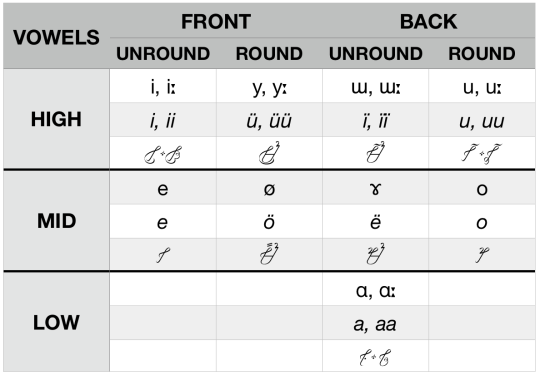
Couple things here. First, you’ll notice long vowels for everything but mid vowels. This is my “Don’t make actors pronounce ee as anything other than [i]” sound change. Old long mid vowels broke, becoming a high vowel followed by a mid vowel, as in Finnish (so ie, üö, ïë, and uo).
You’ll also notice some unrounded back vowels. I was nervous about trying to do unrounded back vowels, but I figured since I was going to have constant access to the actors, I’d give it a shot. Turns out I had nothing to worry about. Those unrounded vowels are super easy for English speakers to pronounce. Basically I just said, “These are pronounced like this”, and then they said, “Oh”, and did them right every time. The front rounded vowels still caused problems, but the back unrounded vowels did not. I used diereses to indicate the unrounded back vowels for parallelism. It seems to have worked.
As a final note, the long opposite-rounding vowels have no separate form. This is because though the long vowels are phonemic (in that there are places where you must pronounce, e.g., üü as opposed to ü), there’s actually no way to write them in the orthography. Everything else that has a distinguishable form (as you’ll see) is either a form that was a licit long vowel at one time, or was (or currently is) a licit diphthong. That left nothing for the long opposite rounding vowels.
Here are the aforementioned diphthongs:

If you look at the forms for ie and uo, they should look rather familiar. That’s because these used to be the forms for *ee and *oo, and they’re simply read differently now. You’ll also notice that the forms for üö and ïë are identical to the forms for ö and ë, respectively. That’s because there’s no way to indicate the long form for these vowels, and those are the readings of the long forms of those vowels.
As you look at these, by the way, most of the extra lines and weird swooshes you see were added by request.
The consonantal base forms are as follows:
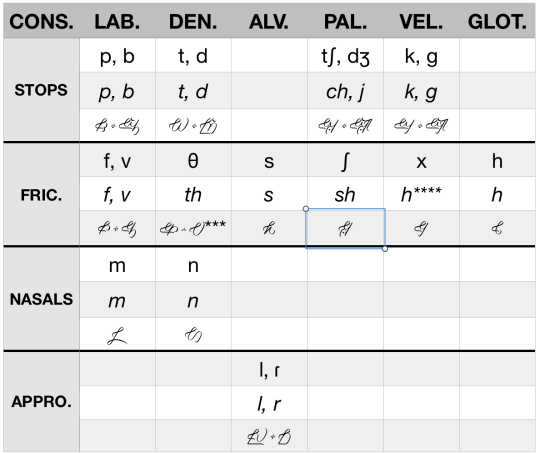
You can ignore the blue box; that was my bad there (screen cap). So like...stuff happened here. Basically, the short forms of stops became fricatives, but then there already was a *th, so all those words just got respelled. So the form with the three asterisks is usually pronounced [s] before [i], and elsewhere it’s [θ], but it’s not used word-initially, unless it’s before [i]. The form with four asterisks is an old consonant that’s no longer pronounced (it’s just regular [h] now), and so there are two [h]’s in this thing.
I added those ridiculous half moons because most stuff was wanted. Also, I thought r was fine on its own, but they wanted the bottom part to extend, so I extended it, along with l. Same extension happened with the word-initial flourish on f and v and like forms. I’m just looking at this now, and I’m like...seems unnecessary...
Anyway, the system is an abugida, which means there’s an inherent vowel, and modifications are added for other vowels. The inherent vowel in this system is short e. This is a fully executed consonant that’s hopefully large enough that you can see it:
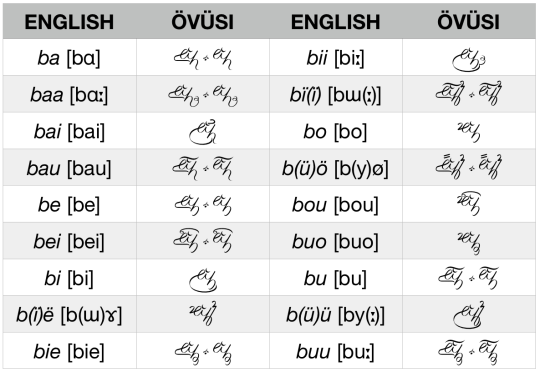
You can also see the “capital” versions that occur for some consonant/vowel combinations above. Basically, when one of these occurs as the first character of a word, there’s an extra flourish. Where there are two glyphs above, the first has the flourish, and so is an initial form, and the other would appear elsewhere in the word. I had a lot of fun coming up with these, but now looking at the extra half moons, the extra loops, the extra double lines on bö... It’s just all too extra for me. But I know what it originally looked like, so I always have something to compare it to in my mind.
Now for the sake of completeness, though it’s going to make this really long, here is the fully executed version of every glyph split into two tables. Here’s table one:
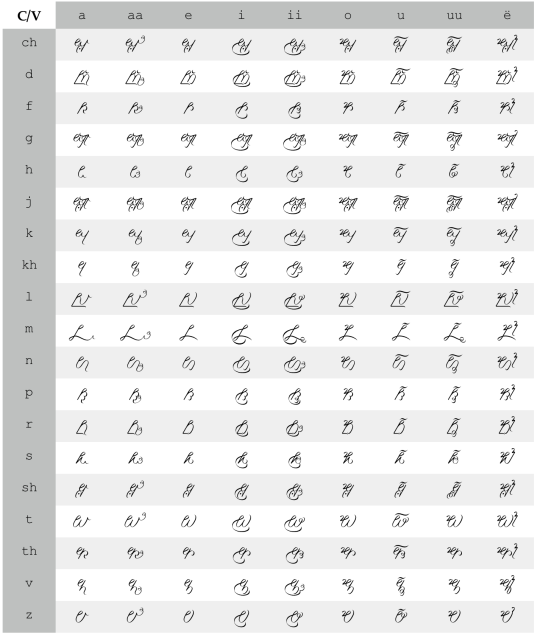
And here’s table two:
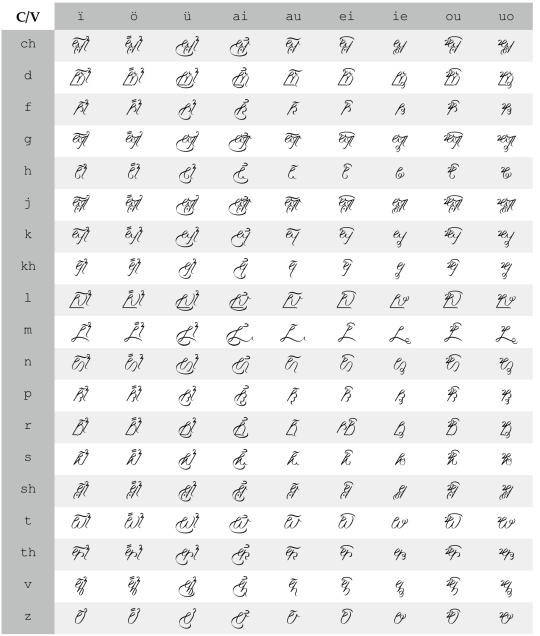
Huh. Weird error in the rei cell... Included one two many r’s it appears... The character’s still there, though. (By the way, the keystrokes are written on the left there. This is for the font. What’s “z” there is the weird old *t sound that’s become [θ] and [s].)
There’s also a geminate marker that, when you see it, you’ll be able to recognize as a reference to Castithan. I’ll show it to you in an example later.
Nouns in Övüsi have a bunch of different declensions. It’s all based on whether the original form ended in a vowel of some kind or a consonant. At this stage of the language, no word can end in a consonant, and the only codas are reserved for the first member of a geminate, so lots of different things happened to these consonant-final forms. There’s no room to show every declension, but I can at least give you one, and give you a sense of the cases themselves. Here they are (singular/plural):
NOMINATIVE: thuoke/thuoki “bird(s)”
ACCUSATIVE: thuokie/thuokii “bird(s) (direct object)”
GENITIVE: thuoka/thuokai “bird’s/birds’”
INSTRUMENTAL: thuoku/thuokï “with the bird(s)”
LOCATIVE: thuokö/thuokü “near the bird(s)”
ABLATIVE: thuokau/thuokavi “away from the bird(s)”
ALLATIVE: thuokaalou/thuokaalli “towards the bird(s)”
INESSIVE: thuokannö/thuokannü “inside the bird(s)”
ILLATIVE: thuokou/thuokoli “into the bird(s)”
ELATIVE: thuokannau/thuokannavi “out of the bird(s)”
PERLATIVE: thuokausu/thuokausï “by way of the bird(s)”
AVERSIVE: thuokasshu/thuokasshï “avoiding the bird(s)”
VOCATIVE: thuokuo/thuokorii “O, bird(s)!”
If you look at these cases, you can probably recognize some of my favorite sound changes, and guess how some of them evolved (and in what order). The nice thing about having a nice big case system like that is it’s just there for you, like your best friend. You don’t really need to fuss about how to say stuff. Your best friend just says, “Shh, shh... Let me show you my cases.” And you take one and you’re good. Like hot cocoa in winter.
Now the verbs...
On a macro level, verbs agree with their subjects in person and number in the first person and sometimes the imperative, and just in person otherwise. Each verb has three stems: the imperfect, the perfect, and the future. Then, depending on whether the verb is dynamic or stative, there are three modes: the indicative, the passive, and the potential (statives lack the passive mode). A copula is used for emphasis, negation, and equation.
It’s best to see an example, and with verbs, the easiest to tease apart are the vowel-final ones. Here’s a table to consider:

This is the verb mikaa, which means “to say” (most of the time the infinitive ends in -ie; it’s just non-e V-final stems that are different). As you can see, the stem part here is probably -i for imperfect; -has for perfect; and, of all things, bare for future. Then there are some more or less predictable suffixes added in the three modes. To those can be added agreement affixes, but they can also be left off. Depending on whether or not they’re added the end of the form changes. The first items in each pair are how the form ends if nothing is added. I’ll show you each in a sec here. First, here’s the agreement paradigm:

Now that you’ve got that, here are two examples (and I’ll show you the orthographic forms, too):

That’s Kenie mikaithorï super large, apparently. Kenie is the third person pronoun in the accusative. Mikaithorï has a third person subject, and is in the potential indicative. Now if you use the emphatic copula instead...

That’s Kenie mikaithou shï! which is “I must say it!” Now, of course there’s nothing in here anywhere that corresponds to “must”: It’s simply the interpretation. These examples show how you use the form with the agreement suffix and without.
(Also, see the geminate thingy in there? The spelling in this one is weird.)
That’s a basic intro to this thing. It was actually a pain in the butt to use, but fun to speak. All in all pretty good. Though weird.
This is a piece the art department put together for Édgar Ramírez’s Kandomere to wear. I thought it looked pretty boss:

Looks pretty cool, until you realize it says the following...

And he’s one of the good Elves! lol This was one of my favorite pieces. That art department was amazing.
So that was what I was up to this time last year. Again, if you get a chance to see the movie, I hope you enjoy it! Süvorii!
#conlang#language#Bright#Netflix#Övüsi#Övüsi grammar#Ovusi#Ovusi grammar#conscript#orthography#Elvish#elf#elves#Castithan#Defiance
2K notes
·
View notes
Note
Heya! How do you say 'I love you' in Övüsi and Bodzvokhan?
Here it is in Övüsi:
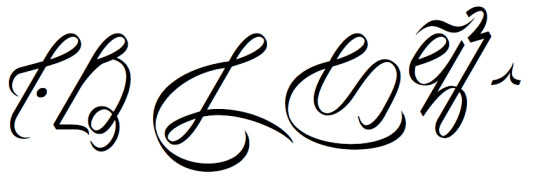
Arie minivï.
And here it is in Bodzvokhan:

Ǝngilǝ.
For the latter, could also do just ǝngil. Ǝngilǝ seems more emphatic and/or more formal.
For writing Bodzvokhan (lol that image is so comically large… They’re both the same font size! Come on, Tumblr!), initial ǝ is almost never written, and final ǝ is rarely written. When it is, it’s written with the same character as a, so in something like this (a very common expression), the three characters are all that are used. Looks kind of funny with the period, but you, it actually says “I love you” in full, but also has the visual effect of “i❤️u”.
Thanks for the ask!
#conlang#language#Bright#Bright film#Bright Netflix#Netflix#conscript#orthography#Övüsi#Ovusi#Övüsi grammar#Ovusi grammar#Bodzvokhan#Bodzvokhan grammar#Anonymous
118 notes
·
View notes
Note
You're amazing dude! Keep up the awe-inspiring work!

Arie vaulishimï!
“Thank you” in Övüsi. :)
#conlang#language#Bright#Bright film#Bright Netflix#Netflix#Övüsi#Övüsi grammar#Ovusi#Ovusi grammar#Elvish#Anonymous
63 notes
·
View notes
Note
there is feminine version for Aeksios in High Valyrian? or can be used for either both sexes? also I want to know the formal and informal ways that you can address someone in övusi and Bodzvokhan.
The word āeksios does not distinguish between men or women (many words of High Valyrian are like that). As for Övüsi and Bodzvokhan, neither language has a system of formal address like Spanish or French. In fact in Övüsi you don’t even distinguish between singular and plural for second or third person. That’s a fun one to use. :)
#conlang#language#High Valyrian#Valyrian#High Valyrian grammar#Valyrian grammar#HBO#Game of Thrones#Bodzvokhan#Ovusi#Övüsi#Bright#Netflix#Bright Netflix#armodeasgoroyi
17 notes
·
View notes
Note
Thank you so much! ☺
Hi there! I was hoping you wouldnt mind translating "Ma" and "Pa" to Bodzvokhan? :)
In Övüsi, mother is naame, and father is abo. In Bodzvokhan, mother is dats, and father is bokh.
Thanks for the ask!
#conlang#language#netflix#bright#bright netflix#bright film#bodzvokhan#bodzvokhan grammar#övüsi#ovusi#övüsi grammar#ovusi grammar#elvish#orcish#morphinetune#bell peppers
38 notes
·
View notes